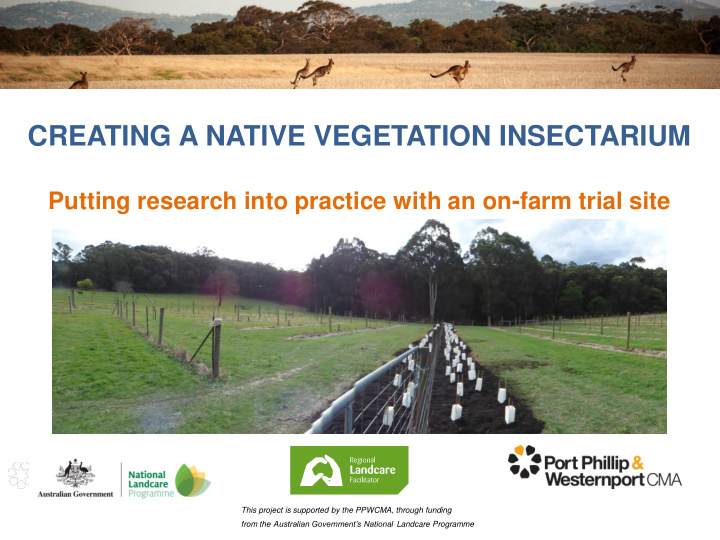



CREATING A NATIVE VEGETATION INSECTARIUM Putting research into practice with an on-farm trial site This project is supported by the PPWCMA, through funding from the Australian Government’s National Landcare Programme
The multiple benefits of having native vegetation on your farm • Shelterbelt • Habitat and food source for insects- (insectariums, beetle banks, insect corridors) • Biodiversity values (consider offsets in planning applications) • Meet obligations in Environmental Assurance programs • Bush Food production- income diversification
1. Biodiversity Interactive Map: Look up the relevant Ecological Vegetation Class (EVC) for your property Weblink: http://mapshare2.dse.vic.gov.au/MapShare2EXT/imf.jsp?site=bim
Step 2: Zoom in to the area you are looking at. I select a scale of 1:10,000 or 1:20,000 depending on how much Step 3: Click on the yellow folder and turn on the 2005 information is needed. EVC layer. Then refresh the map.
Click on legend to bring up the map key for each EVC
Click on the pdf icon and fill out the details. Click OK. A hyperlink with open map will appear. Click on the link
http://www.depi.vic.gov.au/environment-and-wildlife/biodiversity/evc- benchmarks#bioregionname From this web link, you can scroll down past the bioregion map to a table which lists each of these bioregions and hyperlinks to their EVC benchmark. Below is the Highlands- Southern Fall as Yellingbo is in this bioregion. Open the word or pdf file. Look up the relevant EVC numbers listed in your property EVC Map.
http://www.mapimage.net/IntraMaps75/ApplicationEngine/Application.aspx?project=Yarr a+Ranges&configId=bf9bd338-12aa-43f2-95aa-a491de0b3a8d Type in an address then click on the Indigenous Vegetation Community List to obtain EVC plant lists specific to that address!
Look for plants which you have seen featured in the research as appropriate insectarium species Quite a few relevant EVC’s have bush foods, you just need to know what you are looking for Plant a mix of EVC plants depending on the layout of your insectarium The more plant diversity and layers, the better the habitat for diverse beneficial insects
CUSTOMISED SITE PLANTING GUIDE Using the EVC list you have for the property, start to highlight plants you know are highly beneficial in an insectarium: Sweet bursaria, wallaby grass, prickly tea-tree are the three HERO plants What else is on your list that matches your planting space/layout and will provide nectar and pollen? Shelterbelt- Upper and Middle story flowering plants Insectary plants- HERO plants and similar ones found in your EVC. Make sure there is diversity in your strata layers and include groundcovers. The customised list for Fieldberberry Farm is available at: http://www.ppwcma.vic.gov.au/news/publications/ NB: this is specific to this farm and is a GUIDE only.
• Upper story (shelterbelt)- E. olida • Middle story- (shelterbelt)- Bursaria spinosa, Prostanthera lasianthos • Lower story- grevillea, Acacia , correa sp , round leaf mint bush, parrot pea, bush pea, heath, daisy, honeypots, river mint, lilies, grasses • Groundcovers- native violet, running postman, pussytails, muntries etc
Your insectarium layout can be any design you like • Grasses under vine or inter-row, end of row strainer posts • Surrounding a dam • Land class zoned unsuitable for production • Garden beds • Headlands, buffers and re-vegetated shelterbelts It’s about insect corridors and connectivity to native vegetation
Grevillea Acacia Heath Kunzea rosmanifolia suevolens pomifera * Native Mentha Themeda Euc olida grasses australis triandra (strawberry gum) * Wallaby, Weeping and Spear)
Is it working? • Spring in Victoria hasn’t been kind if you want to monitor insects! 10 sticky traps, one week (7 days) each month Sept-Jan 3 pit fall traps in the main insectary planting, one week each month Sept-Jan Monitoring for increases in abundance and diversity of beneficial insects over next 2 years, longer if my RLF project is re-funded!
Is it working? • Spring in Victoria hasn’t been kind if you want to monitor insects! • However, 7 weeks after planting, some native plants were already flowering and spiders moving in to the insectary
How much did it cost? Insectarium Costs- indicative start-up costs for any property EXPENSE ITEM COST CALCULATION COMMENTS based on tubestock prices averaging $2 60m row x 2m wide, some indiegnous nurseries are cheaper, native indigenous plants x380 760 each commerical nurseries more expensive Eucalypt windbreak (optional) x based on tubestock prices averaging $2 some indiegnous nurseries are cheaper, commerical nurseries 10 plants 20 each more expensive tree guards x 380 342based on .90c/tree guard and stakes bulk buy sticky traps x90 34optional for IPM monitoring monitoring Baseline September 1 week x 10 traps. Oct-Jan (4 months). 10 traps over a week x 4 weeks (one IPM monitoring (optional) 1500$30/trap. Optional analysis/month) = 50 traps total IPM monitoring (optional) 360$30/pitfall trap 3 traps in main insectarium $90 each analysis x 4 months snap lock bags & postage for sticky traps 60approx. post to Melb Uni variable depending on product used, amount required, Mulch 200050m3 transport distance and hire of a spreader TOTAL 5076 without IPM monitoring 3216
Recommend
More recommend